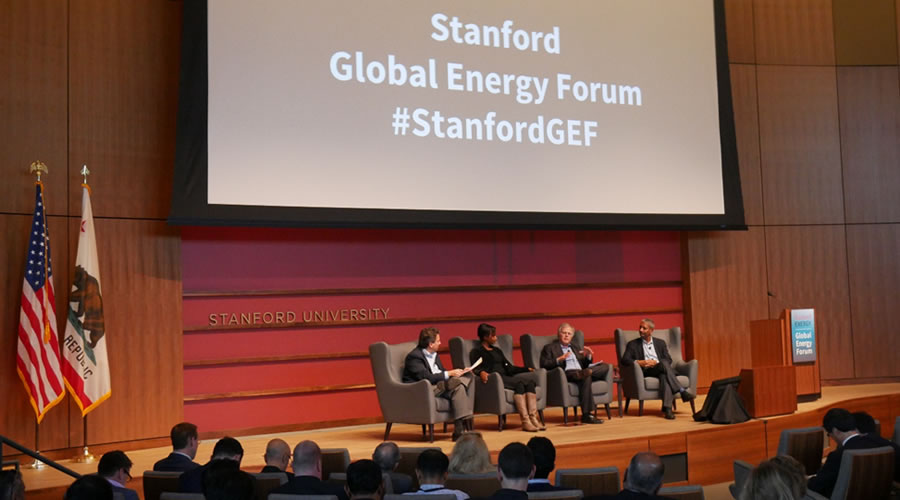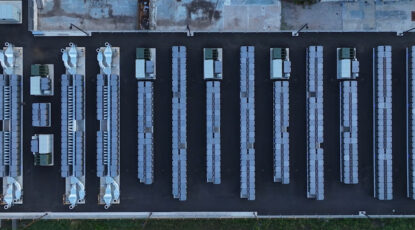What does it take to “make it” as a cleantech startup?
According to a trio of cleantech founders who recently spoke at Stanford University, this is what you need to know: pursue an aspirational mission; master the art of strategic financing; and know that mindset matters more than skillset.
The providers of this advice are worth listening to: Richard Swanson left Stanford’s faculty in 1991 to found and work at SunPower. His work set the standard for solar PV efficiency such that he could be considered a founder of the American solar industry.
KR Sridhar is the founder, CEO and Chairman of Bloom Energy. Under Sridhar’s leadership, Bloom has become the world leader in the stationery fuel cell market. The company’s annual revenue run rate now tops $750 million, and Bloom enjoyed a successful IPO on the NYSE this summer.
Etosha Cave is co-founder and Chief Science Officer of Opus 12, a company that is still early in its journey but which is already revolutionizing the way we think about recycling carbon emissions.
For the record, the moderator whose role it was to interview these leaders is no cleantech slouch either. As founder of DBL Partners Ira Ehrenpreis has invested in more than a dozen cleantech companies, including Tesla, Advanced Microgrid Solutions, and NEXTracker. Ehrenpreis himself is a board member of Tesla Motors.
So what about that advice? Ehrenpreis invited comment with one of his favorite quotes on the topic of entrepreneurship: “First they ignore you, then they laugh at you, then they attack you, and then you win.”
So how do you get to be a winner?
Focus on the Mission
Sridhar’s journey as CEO of Bloom Energy began during the dot-com crash of 2001. He steered the company through an early heyday in the cleantech boom, navigated the great recession of the late 2000s, and persevered to lead Bloom to its latest chapter as a public company.
Through all the highs and lows, Sridhar said there was one constant: Bloom’s mission to make clean, reliable, and affordable energy for everyone in the world.
“Even today, I look at the map of the world and see that there are more people on the planet without access to electricity than when electricity was invented. That’s a moral issue. In a digital world, not having access to affordable electricity is not having access to a future,” Sridhar said.
“Having [a mission] that strong, that goes well beyond the profit and loss, and beyond the everyday stuff, is essential to being able to weather through the ups and downs.”
Swanson echoed Sridhar’s sentiments: “The key from my perspective was to recognize early on that we needed renewable energy, and that vision sustained me through all the laughter and the ridicule.”
Approach Financing Strategically
Being a mission-driven entrepreneur isn’t enough to make it in cleantech. “The financing side has really become the biggest risk in the [cleantech] sector,” forcing entrepreneurs to be creative in acquiring funding and strategic in approaching financing, argued Ehrenpreis. “You have to be financially adept.”
Cave, who co-founded Opus 12 in 2015 has demonstrated plenty of adeptness. Her company has secured funding via three targeted buckets of financial resources: philanthropic funding, which kept the company focused on its mission; government funding, which helped progress technology development; and institutional investors, who have helped drive a focus on commercialization. The approach has worked for Opus 12. Thus far, Cave has attracted close to $20 million in funding.
Bloom Energy’s fundraising has been at an entirely different level to Opus 12 yet similarly resourceful. The company has raised more than $1 billion in financing to fund breakthrough advances in materials science, chemistry, and manufacturing.
Reflecting on fundraising during good times and bad, Sridhar recalled fundraising successes that defied the odds.
“People think when things are going badly it’s a bad time to go pitch a new idea. I would say it’s exactly the opposite. People are usually willing to listen when current investments aren’t doing well. I found success pitching to pension funds and sovereign wealth funds with very little experience of cleantech. I told them: There’s always a first time!”
Value Mindset Over Skillset
Without great people, none of these cleantech successes would have been possible. So how did each entrepreneur attract the best of the best, and what do they look for in talent?
Swanson said a problem-solving mindset and the ambition to raise the bar in solar cell efficiency was critical in the early days of the industry. He recounted a time when he declared to a team of manufacturing engineers that “Our first full factory is going to be a million starts a day.” He recalled the shocked look on his team’s faces. When one of the team sought to correct him, asking “you mean a million a year?” Swanson responded, “no, a million a day.” The prospect of attaining goals they hadn’t previously dared think possible thrilled and inspired the gathered engineers.
Sridhar offered a similar perspective on ‘mindset’. He detailed his quest to “gene pool engineer” Bloom’s workforce for three main traits: value set, mindset, and skillset. With skillset being the most straightforward filter, Sridhar concentrated on mindset and value set in order to attract people who could not only endure the sprints of the entrepreneurial world, but also the marathons.
The good news for cleantech entrepreneurs seems to be that more young professionals entering the workforce are looking for this type of meaningful challenge. Cave pointed out that an increasing number of potential employees, and especially recent graduates, want to work for companies that are having an impact on the world.
Contemplating the Future
So, what’s next for cleantech? What other advice did this trio of founders offer to attendees contemplating careers in cleantech?
Sridhar urged the industry to avoid approaching its future in an “or” manner which pits potential solutions against one another. “Let’s not talk about climate change as coming. We are living in a post-climate change world,” he said. “The hundred-year hurricanes are happening three times a year. Our forest fire season is going from four months to eight months here on the west coast.”
“In this post-climate change world, our war is against time and carbon dioxide and we have to fight this war every possible way, from conservation, to reducing the footprint of fossil fuel use, to renewables; all of the above, it cannot be one or the other. You’ve got to think about sustainability not in a single dimension. It’s not going to be ‘Which one is going to win ten years from now?’; it’s always a hybrid solution at the end of the day,” Sridhar advised.
With that, Ehrenpreis wrapped up the panel in the same fashion he started it, with a favorite quote, this time by Alan Kay: “The best way to predict the future is to invent it.” Leaving the Forum with an inspiring call to action, he concluded, “Now is clearly our time to invent the future of energy.”



